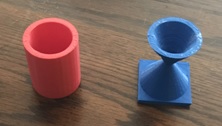
Originally I wanted to do something that dealt with probability because I like gambling and that would have fun to make a math game out of. I soon learned that a lot of probability math games have already been invented and I would just be recycling an old idea and that not really my style. Next I was thinking of using a funnel and having students sift liquids through a tiny hole in the bottom to classify the densities of the liquids, but then I thought that kind of sounds a little bit like a science lesson and then that idea went out the door. So we came up with the idea to have two different shaped funnels each with holes in the bottom and to analyze the difference between how fast the liquid leaves the funnel. We came to this idea because it is an interesting concept and would be a fun hands-on activity. The first funnel will be a straight cylinder hollowed out with a hole in the bottom, and the second will be a vase/funnel shape with a hole in the bottom. Students will be able to hold the manipulative and hypothesize about what is going to happen with each manipulative is filled with water and then drain. Honestly, I am as much of a student as the elementary child is in this experiment. We can both assume that the cylinder shape that is uniform all around, will drain at a constant speed because the shape is equal throughout. How fast it will take will depend on the size of the hole in the bottom and the length of the shape. These are good aspects to bring up to students because they can critically think about how the size of the object and the hole can affect the draining process. It is also a good way to teach students about surface area, because it is my assumption that the bigger the surface area on the top of the water the slower is it going to go drain. I’m not 100% sure this is the correct answer but that is my hypothesis. Once both shapes are printed out and in front of me and the students we can make more accurate hypotheses of what will really happen.
This project will be a nice example of trial and error because there are many different outcomes to happen. The width of the shapes and how hollowed out each is all plays a role in how fast it will empty. Each manipulative is going to have different dimensions but students will be able to identify similarities and differences between the two. Through this, it will teach students the importance of comparing and contrasting different shapes and outcomes. I believe that my manipulative will teach a lot about mathematics and learning over all. An aspect of math is in almost everything we do, whether its calculations, probability, geometry, or in actions we are always using some type of math. The fact that we are using a manipulative already relates to how I believe learning works. To teach a student and have a student comprehend and retain knowledge they have to be interested in the subject or lesson. Standing in front of a class and just lecturing the rules of math may work for some kids, but not all. In my opinion, traditional teaching styles of emulating the teacher as an authoritarian figure worked in educating me but it won’t work for all students. Experimenting with success and failure and how we respond is a better lesson then a teacher lecturing from a text book, whatever the grade level. In terms of success and failure I believe my manipulative will teach something, what that something is I’m not quite sure. through comprehensive Q&A thought, we will find out why our original hypotheses did not pan out and interpret how the results we ended up with happened. In life, I have learned some of my most important lessons through failure, so I do not believe the success and failure of my object would determine the success or failure of the lesson planned.
